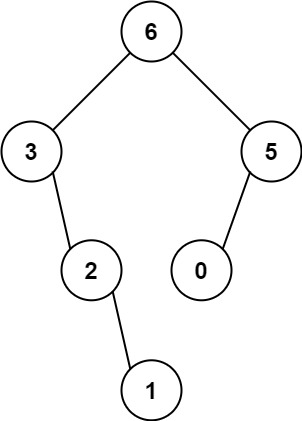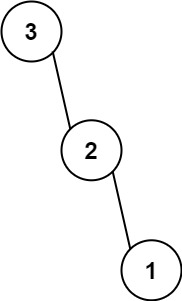描述
You are given an integer array nums with no duplicates. A maximum binary tree can be built recursively from nums using the following algorithm:
- Create a root node whose value is the maximum value in nums.
- Recursively build the left subtree on the subarray prefix to the left of the maximum value.
- Recursively build the right subtree on the subarray suffix to the right of the maximum value.
Return the maximum binary tree built from nums.
Example 1:

Input: nums = [3,2,1,6,0,5]
Output: [6,3,5,null,2,0,null,null,1]
Explanation: The recursive calls are as follow:
- The largest value in [3,2,1,6,0,5] is 6. Left prefix is [3,2,1] and right suffix is [0,5].
- The largest value in [3,2,1] is 3. Left prefix is [] and right suffix is [2,1].
- Empty array, so no child.
- The largest value in [2,1] is 2. Left prefix is [] and right suffix is [1].
- Empty array, so no child.
- Only one element, so child is a node with value 1.
- The largest value in [0,5] is 5. Left prefix is [0] and right suffix is [].
- Only one element, so child is a node with value 0.
- Empty array, so no child.
Example 2:

Input: nums = [3,2,1]
Output: [3,null,2,null,1]
Note:
1 <= nums.length <= 1000
0 <= nums[i] <= 1000
All integers in nums are unique.
解析
根据题意,将 nums 变化为一个最大二叉树,其实看例子一就可以总结出规律使用 DFS 方式来进行解体,DFS 函数的基本逻辑就是将 nums 的最大值作为根 root ,其左边的数组不为空则为左子树,右边的数组不为空则为右子树,然后分别对左子树当前的列表和右子树当前列表执行相同的操作,最后返回 root 即可。
解答
# 方便理解版本
class Solution(object):
def constructMaximumBinaryTree(self, nums):
"""
:type nums: List[int]
:rtype: TreeNode
"""
def dfs(root, left, right):
# if not root:
# return
if left:
mx_left = max(left)
idx = left.index(mx_left)
root.left = TreeNode(mx_left)
dfs(root.left, left[:idx], left[idx+1:])
if right:
mx_right = max(right)
idx = right.index(mx_right)
root.right = TreeNode(mx_right)
dfs(root.right, right[:idx], right[idx + 1:])
mx = max(nums)
idx = nums.index(mx)
root = TreeNode(mx)
dfs(root, nums[:idx], nums[idx+1:])
return root
# 简洁版本
class Solution(object):
def constructMaximumBinaryTree(self, nums):
"""
:type nums: List[int]
:rtype: TreeNode
"""
def dfs(nums):
if not nums:
return
mx = max(nums)
idx = nums.index(mx)
root = TreeNode(mx)
root.left = dfs(nums[:idx])
root.right = dfs(nums[idx+1:])
return root
return dfs(nums)
运行结果
Runtime: 180 ms, faster than 88.01% of Python online submissions for Maximum Binary Tree.
Memory Usage: 14.4 MB, less than 6.51% of Python online submissions for Maximum Binary Tree.
原题链接:https://leetcode.com/problems/maximum-binary-tree/
您的支持是我最大的动力